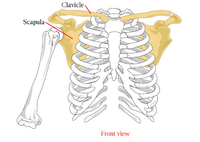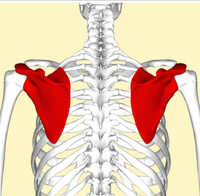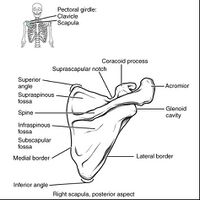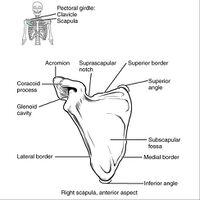Scapular Fracture: Difference between revisions
Niha Mulla (talk | contribs) No edit summary |
Niha Mulla (talk | contribs) (added - Differential diagnosis) |
||
| Line 78: | Line 78: | ||
== Differential diagnosis == | == Differential diagnosis == | ||
Christopher Libby; Nicholas Frane; Thomas P. Bentley. have stated the following possibilities of differential diagnosis in their article "Scapula Fracture".<ref name=":0" /> | |||
* Abdominal Pain in Elderly Persons | |||
* Acromioclavicular Injury | |||
* Fractures of Clavicle | |||
* Mechanical Back Pain | |||
* Pneumothorax | |||
* Rib Fracture | |||
* Shoulder Dislocation | |||
== Management of scapular fractures == | == Management of scapular fractures == | ||
Revision as of 04:43, 25 February 2022
This article is currently under review and may not be up to date. Please come back soon to see the finished work! (25/02/2022)
Original Editor - Niha Mulla
Top Contributors - Niha Mulla and Kim Jackson
Introduction[edit | edit source]
Scapula/shoulder blade is a large triangular bone that lies postero-lateral on the upper back/throracic cage and connects the and is well connected by complex system of muscles. Shoulder blades connect the arm to the thorax while the muscles of scapula ensure correct movement of arm over the thorax. [1][2]
Scapula Fracture (Shoulder Blade Fracture): Scapular fracture is the fracture of scapula which is rare and is often caused by direct trauma from the back or side.[3][4]
Scapular fracture represents less than 1% in prevalence among all other broken bones and 3% to 5% of all shoulder girdle fractures. 80% to 95% of all scapular fractures are accompanied by other injuries like fractures of shoulder, collarbone and ribs, or during injury to the head, lungs and spinal cord, typically because it requires high - energy/torque trauma to cause an injury to scapula . [5][6]
Scapular fractures occur during high-energy trauma such as motor vehicle collisions, falls, and other high impact traumas. Motor vehicle collisions account for over 70% of scapular fractures, with 52% associated with drivers and 18% associated with pedestrians struck by motor vehicles. Other reported mechanisms include electric shock and seizure because of forces on the scapula. Isolated scapular fractures are extremely rare. [6][7][8][9]
Classification of scapular fractures[edit | edit source]
One or more parts of scapula may get fractured:
- Scapular body (45% of patients):The body of scapula fractures into three patterns; transverse, oblique, and longitudinal.[5][6][7]
- Scapular neck (25% of patients): Three types of neck fractures are described as follows: fracture of surgical neck, fracture of the anatomical neck and fracture of neck inferior to scapula spine.[5][6][7]
- Glenoid (35% of patients)[5][6]
Causes of scapular fracture[edit | edit source]
Scapular fracture or broken shoulder blades are caused by direct trauma involving a large amount of force, hence in 80% of scapular fracture cases there are other associated injuries to chest, lungs, and internal organs.[4][8][9]
- Motor vehicle accidents
- Falls with direct trauma to the shoulder
- Falls onto an outstretched arm
- Blunt trauma such as from a baseball bat or hammer
- Fall from height
- Contact sports
- Direct blow to the scapula
Symptoms of fractured scapula[edit | edit source]
- Localized pain at rest
- Extreme pain when moving the arm
- Tenderness
- Swelling around the back of the shoulder
- Severe bruising and scrapes around the affected area
- Holding injured arm close to the body where shoulder is in 90-90 degree position with elbow with shoulder internal rotation.
- Inability to lift the arm
- Flattened and deformed shoulder appearance
- Pain during breathing due to associated chest wall injury
- Numbness, tingling, or coldness of the arm due to impaired blood and nerve supply
- Crepitus and popping sound at the end feel of the shoulder joint movements[3][4][5][8][9]
Evaluation and diagnosis of scapular fractures[edit | edit source]
Diagnosis of fractured scapula is possible only after a proper physical examination and investigations.
- Most scapula fractures are clearly seen in a shoulder and chest x-ray but can easily be missed during examination of the x-ray film. [4][5]
- 80% of the times scapular fracture is associated with other sever injuries which need to be taken into account during patient assessment. Some of these injuries can be potentially life-threatening. For example, thoraco-scapular dissociations with disruptions of the subclavian vein and axillary vessels which can lead to life-threatening hemorrhage. [6]
- CT or MRI scan may be required especially to diagnose the fracture of glenoid which accounts for 35% of all scapular fractures. [5][8][9]
- MRI will give a clearer picture of the extent of injury to the surrounding soft tissue, joints, ligaments and nerves. [6][9]
Differential diagnosis[edit | edit source]
Christopher Libby; Nicholas Frane; Thomas P. Bentley. have stated the following possibilities of differential diagnosis in their article "Scapula Fracture".[6]
- Abdominal Pain in Elderly Persons
- Acromioclavicular Injury
- Fractures of Clavicle
- Mechanical Back Pain
- Pneumothorax
- Rib Fracture
- Shoulder Dislocation
Management of scapular fractures[edit | edit source]
3 5 6 7 8 9
Medical Management:
Non-surgical/conservative Management:
Surgical Management:
Rehabilitation[edit | edit source]
Self care at home[edit | edit source]
8
Follow up[edit | edit source]
8
Prognosis[edit | edit source]
6
References[edit | edit source]
- ↑ Sciascia A, Kilber B, Athwal G, Fischer S. Scapular (shoulder blade) problems and disorders - orthoinfo - AAOS. OrthoInfo. The American Academy of Orthopaedic surgeons ; 2017 . Available from: https://orthoinfo.aaos.org/en/diseases--conditions/scapular-shoulder-blade-disorders#:~:text=The%20scapula%2C%20or%20shoulder%20blade,help%20you%20move%20your%20arm.
- ↑ Scapula . Wikipedia. Wikimedia Foundation; 2022. Available from: https://en.wikipedia.org/wiki/Scapula
- ↑ 3.0 3.1 Scapula fracture (shoulder blade fracture). Johns Hopkins Medicine. Health. Available from: https://www.hopkinsmedicine.org/health/conditions-and-diseases/scapula-fracture-shoulder-blade-fracture#:~:text=What%20is%20a%20scapula%20fracture,from%20the%20back%20or%20side.
- ↑ 4.0 4.1 4.2 4.3 4.4 Scapular fracture. Wikipedia. Wikimedia Foundation; 2021]. Available from: https://en.wikipedia.org/wiki/Scapular_fracture#:~:text=The%20scapula%20is%20fractured%20as,can%20also%20cause%20the%20injury.
- ↑ 5.0 5.1 5.2 5.3 5.4 5.5 5.6 5.7 5.8 Scapula (shoulder blade) fractures - orthoinfo - AAOS. OrthoInfo. 2014. Available from: https://orthoinfo.aaos.org/en/diseases--conditions/scapula-shoulder-blade-fractures/
- ↑ 6.00 6.01 6.02 6.03 6.04 6.05 6.06 6.07 6.08 6.09 6.10 Libby C, Frane N, Bentley TP. Scapula fracture. StatPearls. 2020 Jul 21.
- ↑ 7.0 7.1 7.2 Pires RE, Giordano V, de Souza FS, Labronici PJ. Current challenges and controversies in the management of scapular fractures: A review. Patient Safety in Surgery. 2021 Dec;15(1):1-8.
- ↑ 8.0 8.1 8.2 8.3 Felson S. Broken shoulder Blade. WebMD. WebMD; 2021. Available from: https://www.webmd.com/first-aid/broken-shoulder-blade
- ↑ 9.0 9.1 9.2 9.3 9.4 Hinchey J. Scapula fractures / Orif. John W. Hinchey MD.. Available from: https://www.hincheyshoulderandelbow.com/scapula-fractures-orif-orthopaedic-surgeon-san-antonio-boerne-texas.html










